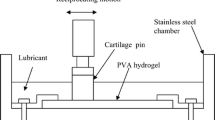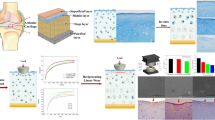Abstract
Many biomaterials are being developed to be used for cartilage substitution and hemiarthroplasty implants. The lubrication property is a key feature of the artificial cartilage. The frictional behavior of human articular cartilage, stainless steel and polyvinyl alcohol (PVA) hydrogel were investigated under cartilage-on-PVA hydrogel contact, cartilage-on-cartilage contact and cartilage-on-stainless steel contact using pin-on-plate method. Tests under static load, cyclic load and 1 min load change were used to evaluate friction variations in reciprocating motion. The results showed that the lubrication property of cartilage-on-PVA hydrogel contact and cartilage-on-stainless steel contact were restored in both 1 min load change and cyclic load tests. The friction coefficient of PVA hydrogel decreased from 0.178 to 0.076 in 60 min, which was almost one-third of the value under static load in continuous sliding tests. In each test, the friction coefficient of cartilage-on-cartilage contact maintained far lower value than other contacts. It is indicated that a key feature of artificial cartilage is the biphasic lubrication properties.











Similar content being viewed by others
References
Linn FC. Lubrication of animal joints. II The mechanism. J Biomechanics. 1968;1(3):193–205.
Wright V, Dowson D. Lubrication and cartilage. J Anat. 1976;121(1):107–18.
Buckwalter, JA. Articular cartilage injuries. Clin Orthop Relat Res. 2002;402:21–37.
Unsworth A. Recent developments in the tribology of artificial joints. Tribol Int. 1995;28(7):485–95.
Benevenia J, et al. Pathologic supracondylar fracture due to osteolytic pseudotumor of knee following cementless total knee replacement. J Biomed Mater Res. 1998;43(4):473–7.
Engh GA, Dwyer KA, Hanes CK. Polyethylene wear of metal-backed tibial components in total and unicompartmental knee prostheses. J Bone Joint Surg B. 1992;74(1):9–17.
Delecrin, J, Oka M, Kumar P. Joint reactions against polymer particles: PVA-H versus UHMWPE. J Jpn Orthop Assoc. 1990;64.
Noguchi T, et al. Poly(vinyl alcohol) hydrogel as an artificial articular cartilage: evaluation of biocompatibility. J Appl Biomater. 1991;2(2):101–7.
Oka M, et al. Development of artificial articular cartilage. Proceedings of the Institution of Mechanical Engineers, Part H. J Eng Med. 2000;214(1):59–68.
Oka M, et al. Development of an artificial articular cartilage. Clin Mater. 1990;6(4):361–81.
Covert RJ, Ott RD, Ku DN. Friction characteristics of a potential articular cartilage biomaterial. Wear. 2003;255(7–12):1064–8.
Pan YS, Xiong DS, Ma RY. A study on the friction properties of poly(vinyl alcohol) hydrogel as articular cartilage against titanium alloy. Wear. 2007;262(7–8):1021–5.
Forster H, Fisher J. The influence of continuous sliding and subsequent surface wear on the friction of articular cartilage. Proceedings of the Institution of Mechanical Engineers, Part H. J Eng Med. 1999;213(4):329–45.
Katta J, et al. Effect of load variation on the friction properties of articular cartilage. Proceedings of the Institution of Mechanical Engineers, Part J. J Eng Tribol. 2007;221(3):175–81.
Northwood E, Fisher J. A multi-directional in vitro investigation into friction, damage and wear of innovative chondroplasty materials against articular cartilage. Clin Biomech. 2007;22(7):834–42.
Pickard JE, et al. Investigation into the effects of proteins and lipids on the frictional properties of articular cartilage. Biomaterials. 1998;19(19):1807–12.
Hyon SH, Cha WI, Ikada Y. Preparation of transparent poly(vinyl alcohol) hydrogel. Polym Bull. 1989;22(2):119–22.
Bloebaum RD, Wilson AS. The morphology of the surface of articular cartilage in adult rats. J Anat. 1980;131(2):333–46.
Caligaris M, Ateshian GA. Effects of sustained interstitial fluid pressurization under migrating contact area, and boundary lubrication by synovial fluid, on cartilage friction. Osteoarthritis Cartilage. 2008;16(10):1220–7.
Forster H, Fisher J. The influence of loading time and lubricant on the friction of articular cartilage. Proceedings of the Institution of Mechanical Engineers, Part H. J Eng Med. 1996;210(2):109–18.
Krishnan R, Kopacz M, Ateshian GA. Experimental verification of the role of interstitial fluid pressurization in cartilage lubrication. J Orthop Res. 2004;22(3):565–70.
Mabuchi K, et al. The effect of additive hyaluronic acid on animal joints with experimentally reduced lubricating ability. J Biomed Mater Res. 1994;28(8):865–70.
Roberts BJ, Unsworth A, Mian N. Modes of lubrication in human hip joints. Ann Rheum Dis. 1982;41(3):217–24.
Shirley Jones E. Joint lubrication. Lancet. 1936;227(5879):1043–5.
Bell CJ, Ingham E, Fisher J. Influence of hyaluronic acid on the time-dependent friction response of articular cartilage under different conditions. Proceedings of the Institution of Mechanical Engineers, Part H. J Eng Med. 2006;220(1):23–31.
Northwood E, Fisher J, Kowalski R. Investigation of the friction and surface degradation of innovative chondroplasty materials against articular cartilage. Proceedings of the Institution of Mechanical Engineers, Part H. J Eng Med. 2007;221(3):263–79.
Mow VC, Lai WM. Recent developments in synovial joint biomechanics. SIAM Rev. 1980;22(3):275–317.
Crockett R, et al. Imaging of the surface of human and bovine articular cartilage with ESEM and AFM. Tribol Lett. 2005;19(4):311–7.
Kobayashi S, Yonekubo S, Kurogouchi Y. Cryoscanning electron microscopic study of the surface amorphous layer of articular cartilage. J Anat. 1995;187(2):429–44.
Orford CR, Gardner DL. Ultrastructural histochemistry of the surface lamina of normal articular cartilage. Histochem J. 1985;17(2):223–33.
Anseth KS, Bowman CN, Brannon-Peppas L. Mechanical properties of hydrogels and their experimental determination. Biomaterials. 1996;17(17):1647–57.
Stammen JA, et al. Mechanical properties of a novel PVA hydrogel in shear and unconfined compression. Biomaterials. 2001;22(8):799–806.
Acknowledgments
This research was supported by the national natural science foundation of China (No. 50535050). Articular cartilage donations by Shanghai Changzheng hospital were greatly appreciated. Many thanks to Prof. Zhang Dekun, Dr. Wang Shibo and Dr. Meng Baoxing of China University of Mining and Technology for their technical assistance.
Author information
Authors and Affiliations
Corresponding author
Rights and permissions
About this article
Cite this article
Li, F., Su, Y., Wang, J. et al. Influence of dynamic load on friction behavior of human articular cartilage, stainless steel and polyvinyl alcohol hydrogel as artificial cartilage. J Mater Sci: Mater Med 21, 147–154 (2010). https://doi.org/10.1007/s10856-009-3863-5
Received:
Accepted:
Published:
Issue Date:
DOI: https://doi.org/10.1007/s10856-009-3863-5




